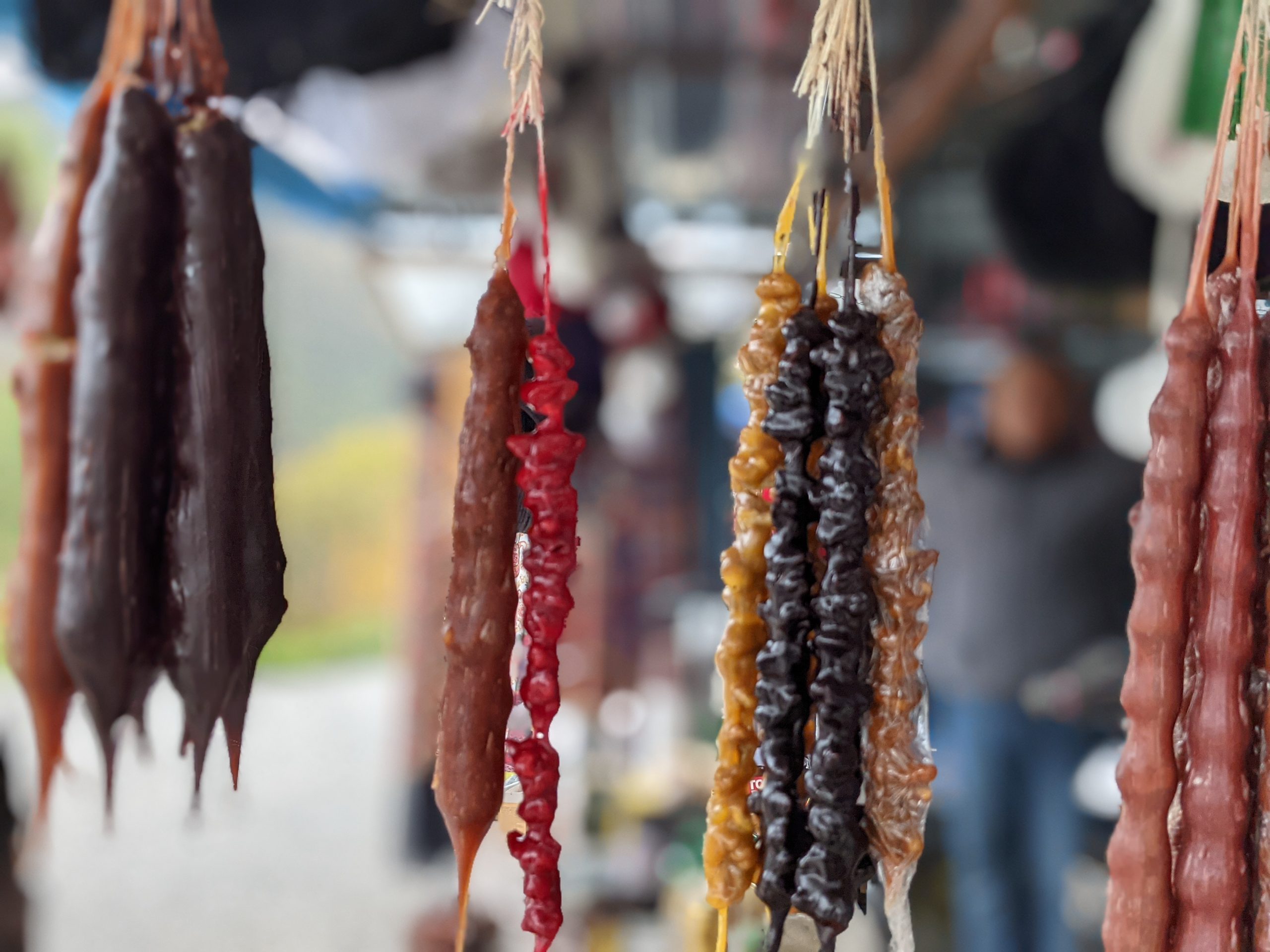Eating and Traveling as a Vegan in Tbilisi, Georgia

Eating vegan while traveling in Georgia (the country) is a study in contradictions. Many countries may not have a lot of accidentally (or religiously) vegan street food or restaurant dishes, but you can generally count on markets and shops to hook you up. When in doubt, grab a jar of Barilla pasta sauce (Barilla – the ubiquitous fall back for vegans who travel) and a bag of dried pasta.
But Georgia. Georgia is different.
I personally had a hard time finding vegan options in grocery stores and markets. There are a couple reasons, I think.
- In Tbilisi, most markets are itty bitty neighborhood shops. While there are a few big grocery markets, they’re more destinations than places you stumble upon. And when I say itty bitty, I mean teeny tiny. They simply don’t have a lot of room to carry much on their shelves, and what they do carry isn’t exactly ‘meal-ready’. See point 2.
- Tbilisi still operates traditionally in a lot of ways. And food access is one of these ways. The butcher shops have the meat, fruit and veggie stalls for the produce, and their backyard for chacha (I kid. Kind of.). Come to think of it, now I’m not sure where they get their beans and grains. So the markets generally have chips/crisps, candy bars, and a large dairy aisle. Which to me means BONUS I GET TO EAT CRISPS ALL THE TIME (and I do).
- Tangentially related, Google Fi (my carrier) doesn’t seem to work in all of Georgia (the country). (It’s one of the countries listed as working, but both I and another American I met couldn’t ever get our data to work here). Why is this relevant? I use Google Translate when I’m grocery shopping to read ingredients, especially in a meat-centric country like Georgia. And since I couldn’t use it in the store, I generally played safe and didn’t buy things like instant noodles or other potentially-happy food I would normally. (Aside – my American friend called Google to troubleshoot and they confirmed their service didn’t work in Georgia. So she went out and bought a sim card. I did none of the above and just went with the flow, only using wifi for the month I was there. What I am trying to say is that if you are proactive, your odds are probably better at having things actually work for you. But I guess I like to make things difficult for myself)

Anyhoodle, so I actually found myself eating out in Tbilisi way more than I anticipated. And it was WAY easier than I anticipated! I find myself missing Georgian food more than any other region I’ve traveled to recently. Here are a couple of my favorite dishes:
Khinkali (pronounced hing · kaa · lee)
Georgian dumplings, basically. Usually made with meat, but you can find mushroom or potato khinkali almost everywhere. There is a specific method to eating these! You take the ‘handle’ and bite into the khinkali and sort of suck out all the juices (like a hungry khinkali vampire), then you can eat the rest of the dumpling. But don’t eat the handle! That’s a cultural faux pas! (though I do it because I’m the boss of me and I like how they taste!)
I was told the khinkali with vegetables were vegan at most places I went to, but it can’t hurt to double check about the dough if you’re cautious.
Salati Nigvzit

Georgian salad – plump juicy tomatoes, cucumbers, white onions, bunches of fresh herbs. Super simple, super delicious (even coming from this person who has complicated feelings about tomatoes!) You can usually order the salad with or without crushed walnuts.
Lobio
Basically bean stew. Usually it’s cooked with onions. One time it was served with fresh jalapenos! That was awesome. Cilantro on top. It’s traditionally served in a little clay pot. It’s cute AND it’s delicious! You can make this at home easily, and it’s better, IMO, if you add Khmeli Suneli, which is a Georgian spice blend.
Lobiani
My love 😍 If you’ll notice, it’s a similar word to the bean stew, lobio, above. It’s made of mashed and seasoned beans, which are then cooked in a chewy and warm dough, similar to pizza dough (Come ON). You can buy these in restaurants or from dozens of street stalls around Tbilisi. They’re typically 2-2.5 GEL, which is .70 -.80 cents. I did my best to eat one every day, because I’m no lobiani dummy.
I made these once when I returned home to Portland using Trader Joe’s pizza dough, canned beans, and Khmeli Suneli, brushed with a lot of Miyoko’s butter. Very lazy-vegan take on lobiani, so naturally I loved it. Highly recommend.

Pkhali
Traditional Georgian dish made with steamed and chopped vegetables (usually spinach, but ingredients can vary) and crushed walnuts. Usually topped with pomegranate seeds. I discovered this late in my Georgia game, but once I did, game over. Such a good way to actually get your veggies in, if you’re a carb-loving vegan traveler like myself. I made this back at home once too, and it turned out almost as tasty as the ones I tried in Georgia.

Akhali Kartophili

Another word for: potatoes! Typically, these are new or fingerling potatoes boiled, mixed with herbs and spices like scallion and dill, then fried in oil and butter. You can ask for no butter.
Ajapsandali

Georgian eggplant stew. Those who know me may be surprised to hear that I actually tried this dish, traditionally made with eggplants, tomatoes, and yes, sometimes even zucchini. My holy trinity of ewwww. BUT! You know, A) When in Georgia and B) when slathered on bread and used as a spread, almost anything can taste good. Did I love it? No. Would I eat it again? Probably. Do I recommend it? Sure, if you’re an eggplant lover.
Bread
- Shotis puri is canoe shaped bread made in a special earthen oven. This stuff is served at most restaurants, and if you have a chance to meet any local families or take a tour, you might get a chance to see this bread making in action – or better yet, make some yourself!! What a cool and special experience. Mad props to the women who do this every day.
- Mchadi is corn bread. It’s dry and it’s bland, but when eaten with lobio (the bean stew) or just when really hungry after a lot of Georgian wine, it can hit the spot.
Sauces
There are a lot of sauces used and ordered in Georgian cuisine. I didn’t experiment with many of them, but I believe one of the most popular ones – a plum sauce called Tkemali – is naturally vegan. When I looked it up just now to get the spelling right and double check the ingredients, it actually looks really good! Here’s a random recipe of Tkemali I found off the internet that I will be making ASAP.
Churchkhela
A traditional Georgian candle-shaped candy. Made with grape must (left over from the wine making process originally), nuts (usually walnuts) and flour, these are threaded on a string and dried in the shape of a candle. These days they’re frequently made with other flavors like pomegranate and honey, and people go nuts with other kinds of nuts as well. These are much more interesting to look at than to eat, in my opinion. But! At one of the apartments I stayed in (one of my all time favorite short-term rentals ever), the host provided wine (naturally), mineral water (of course), fruit (heck yeah) and homemade Churchkhela (yum). And the homemade stuff was leaps and bounds more flavorful than the ones I tried from the market stalls.
** Not eaten is khachapuri, the Georgian food everyone goes crazy for! It’s like a pizza boat with cheese, served with egg and butter. They’re beautiful, but very much not vegan.
A couple other potable honorable mentions:
Wine
Georgia is known as the birthplace of wine. It is plentiful, it is delicious, it is good. Stay tuned for a second post about the wine in Georgia. Stay thirsty.
Chacha
So so many regions in the Balkans, Eastern Europe and the Caucasus have a regional*** potent*** alcoholic drink. Georgia’s is a brandy called Chacha. And I can vouch that it is, in fact, very strong. Chacha is a wine byproduct made with pomace, which is the unused parts of the vines like stems, skins and seeds. The fun part of chacha (for me) is when they flavor it with popular regional herbs, like tarragon! https://www.tasteatlas.com/chacha

Mineral Water
Georgia is known for its mineral water, and the most famous brand is called Borjomi. If you like mineral water, you will like Borjomi (I do). Borjomi is a popular export to many other countries – I first tried it in Ukraine. And you can even tour the Borjomi plant, located in the town also named Borjomi. Note; while researching this section, I came across this article about the war’s impact on the Borjomi plant and the people who work there. I’m not sure at this date if the plant is still shut down, but the article is worth a read.
Have you tried any of these? Which of these sounds the best to you? Do you have any questions about eating vegan food while traveling in Georgia (the country)? Let me know in the comments!

Disclaimer: All opinions expressed here are my own. All information contained here was true at the time of writing. Please do your own due diligence on vegan food while traveling with what makes YOU happy and comfortable.



Beautiful